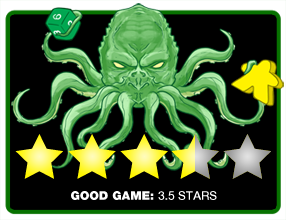Many technique board players have encountered the well-meaning acquaintance who exhibits a well mannered curiosity in our passion.
Acquaintance: So that you’re into board video games, huh? Do you play numerous UNO and Monopoly?
Board gamer: Pauses, resisting the urge to disparage Monopoly. I principally play strategy-oriented video games, geared in direction of ADULTS. Type of like chess, besides extra trendy. Have you ever heard of Catan?
Acquaintance: Dropping curiosity. Uh, no. However sounds cool! Gee, have a look at the time; I’d higher get going.
Thus it was with a combination of pleasure and embarrassment that I endeavored to attempt AllPlay’s Twinkle Twinkle, together with the enlargement, “How I Marvel” — a sport clearly impressed by the youngsters’s nursery track—with my group of undoubtedly non-child-aged players. Twinkle Twinkle is a tile-drafting sport that has 2-4 gamers competing to assemble essentially the most spectacular star chart from nighttime observations over 20-Half-hour. Cutesy teddy bear player-piece, field artwork, and title apart, this can be a puzzly summary sport that may be loved by youngsters and adults alike.
Gameplay Overview:
Every spherical of Twinkle Twinkle could have two rows of astronomy-themed tiles out there for draft on a standard statement board. The highest row is out there for the present spherical, and the underside row is a preview of what is going to be out there to draft within the upcoming spherical.
In flip order, gamers will place their player-tokens atop the tile they wish to draft. As soon as all gamers have positioned their player-tokens, they may concurrently take their chosen tiles and place them anyplace on their private 4×5 star chart boards.
The placement of player-tokens left to proper within the present spherical will decide participant order for the next spherical.
The sport ends when every participant has utterly stuffed their star chart with tiles.
Every of six distinctive celestial components that gamers have collected on tiles might be scored in line with their particular necessities.

Recreation Expertise:
A standout component of Twinkle Twinkle is its look: the tiles are all clear acrylic with the celestial components printed with white ink, and these are positioned atop a fluorescent-appearing night time sky on the private star charts that lets the constellations, planets, comets, and so forth. virtually seem as in the event that they’re glowing. It’s a lovely manufacturing.
The gameplay itself is easy tile drafting and placement with some added participant interplay stemming from the flexibility to affect flip order when choosing your present tile. Early-game, the selections really feel open-ended as a result of your star chart is empty and you might be free to determine priorities. Every of six distinctive celestial components within the sport has totally different standards to maximise its scoring; most have to be adjoining to or NOT be adjoining to different particular sorts of celestial objects.

Stars can rating in three alternative ways relying on the scale of multi-star constellations and the general variety of 2+-size constellations. With every tile positioned, your choices for maximizing scoring with the subsequent tile have been marginally extra constrained, and by late-game, tensions are at their peak; greatest scoring choices for every participant have dwindled based mostly upon their earlier selections, and early turn-order takes on the best significance. Twinkle Twinkle finally feels extra constraining than Cascadia, however a lot much less so than Calico.
Whereas the principles are easy sufficient, with 6 distinctive components scoring in 8+ alternative ways, the flexibility to see what’s developing for the draft subsequent spherical, and the choice to affect turn-order means crunchy selections abound. Lightweight players is likely to be overwhelmed on their first play, however they need to get the cling of it shortly sufficient; Twinkle Twinkle’s weight is just like that of Harmonies.

Stars all the time have the identical three scoring standards, however variability is launched from two totally different scoring choices for every of the opposite 5 celestial objects (inexperienced = normal, blue = superior), which could be blended and matched game-to-game. If performed with the “inexperienced” aspect for each celestial object, the sport isn’t too punishing; with few exceptions, you’re virtually assured at the very least 1-2 factors for any given tile placement.
The blue aspect is trickier. Black holes can begin negating factors from sure different celestial components. Asteroids subtract 5 factors from the participant with the fewest. Conversely, planets award 8 factors to the participant with essentially the most. I personally don’t love this free/unfavorable factors for essentially the most/fewest scoring idea at two-players, as it could actually make the sport swingy, nevertheless it’s nice at increased participant counts. Regardless, whereas two scoring choices for every celestial object are good, the bottom sport nonetheless pales to the better variability supplied by Cascadia.

The How I Marvel Enlargement vastly improves replay worth by offering 5 further celestial objects (every with inexperienced/blue sides) that may be mixed-and-matched with the bottom sport, such that 5 complete objects are in every sport along with stars. Every of those new objects has fascinating scoring situations, and a few can actually change the gameplay past fundamental scoring. For instance, wormholes permit gamers to alter the tiles out there for subsequent spherical’s draft. Rocketships give a brand new incentive to construct massive constellations. UFOs, a part of a separate mini-expansion, is likely to be my favourite, as they step by step enhance the scoring worth of sure objects as the sport progresses.
The enlargement is a implausible addition, nevertheless it does have some notable logistical limitations. Most of the new objects, in addition to a number of the originals (4 complete out of 11 non-star objects) require particular different objects to be within the sport for his or her scoring to work; thus set-up can’t be utterly randomized. Including to the fiddliness is the necessity to kind all however the star tiles both originally or finish of every sport. Yet another nitpick whereas I’m at it: the enlargement content material can’t match into the unique field.
Remaining Ideas:
Twinkle Twinkle is a solidly-designed summary sport about the identical weight and playtime as Harmonies, however with fantastically applied astronomical theming as an alternative. Participant interplay is elevated a bit above related drafting video games due to the flexibility to preview the subsequent spherical’s choices and likewise affect flip order with every draft decide.
The bottom sport consists of some variability with two scoring choices for 5 of the celestial objects, however it’s nonetheless no match for the variability of Cascadia. The “How I Marvel” and UFO expansions add extra sturdy replay worth and a few cool new gameplay components with out an excessive amount of extra complexity, although they make set-up/tear-down extra fiddly, and it should be famous that they won’t all match within the base-game field. Twinkle Twinkle just isn’t re-inventing the class of summary video games, nevertheless it nonetheless gives a large amount of enjoyable in a brief playtime, together with deeper selections than the title would suggest.
Remaining Rating: 3.5—a brief and candy astronomically-themed tile-drafting summary sport with a manufacturing that’s out of this world
 Hits:
Hits:
• Stellar manufacturing
• Respectable participant interplay
• Elegant design
Misses:
• Restricted replay worth within the base sport, principally mounted by enlargement
• Enlargement doesn’t match within the base-game field
• Set-up turns into fiddly with enlargement


